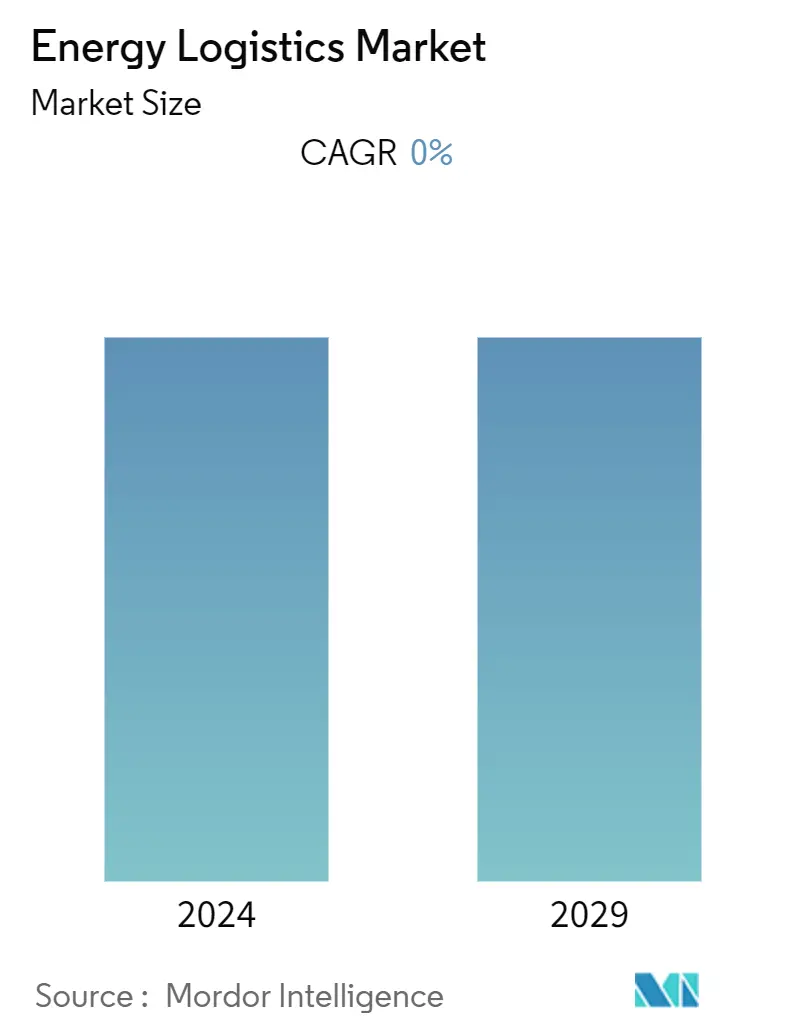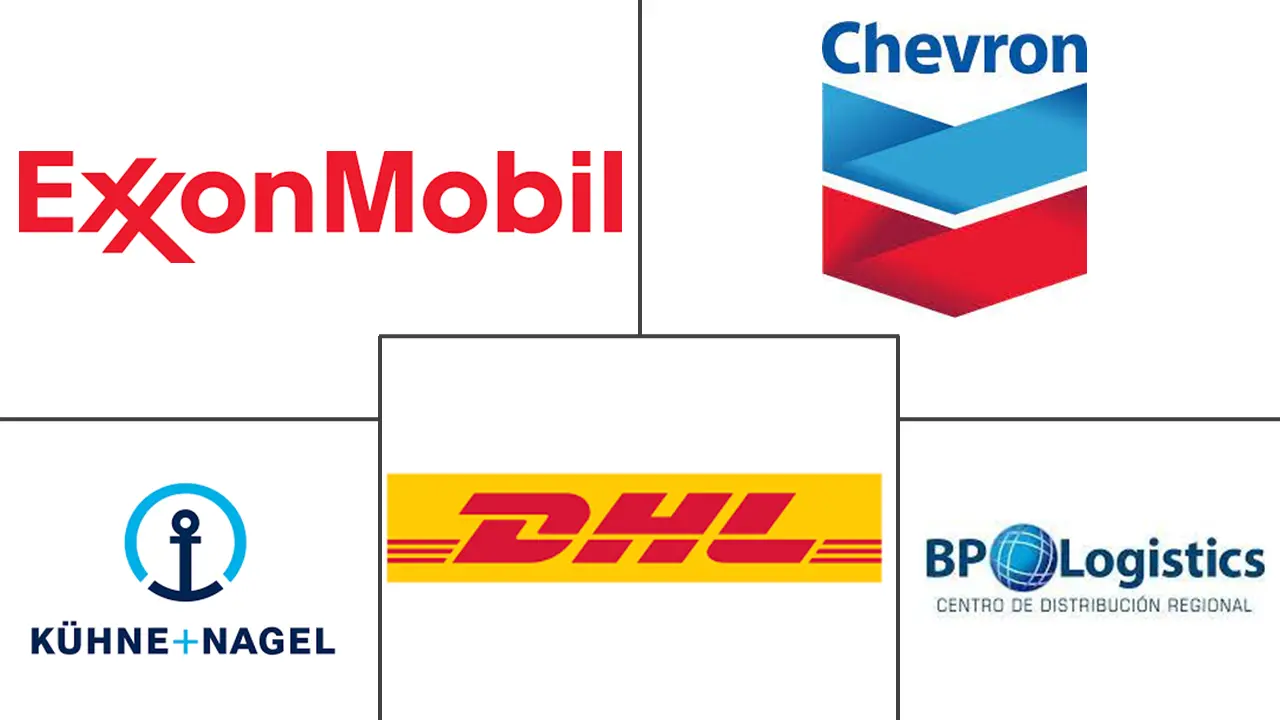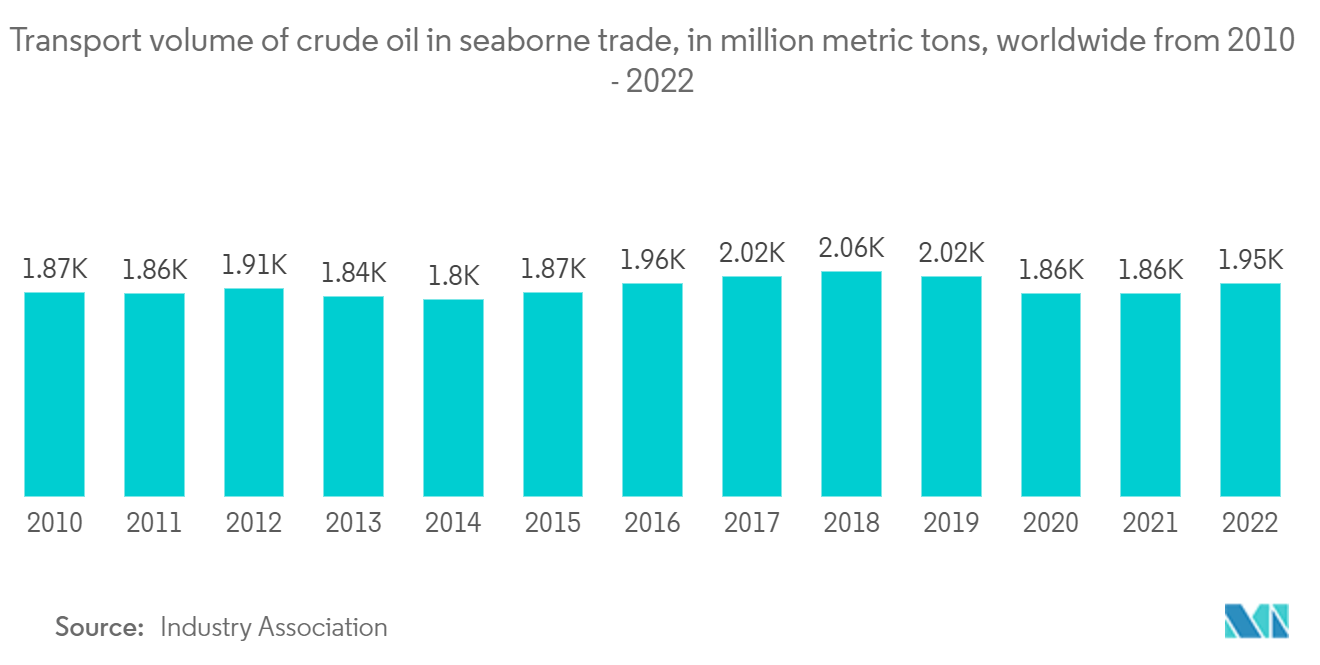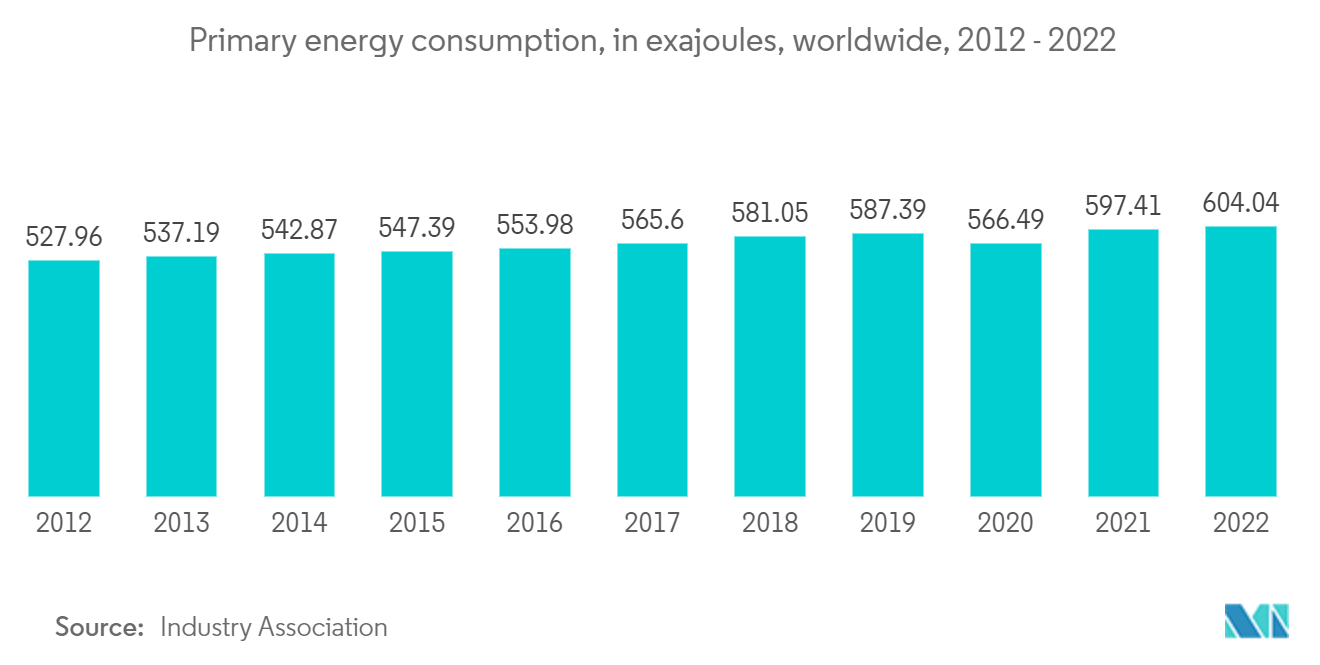Energy Logistics Market Size

| Study Period | 2019 - 2029 |
| Base Year For Estimation | 2023 |
| CAGR (2024 - 2029) | 0.00 % |
| Fastest Growing Market | Asia Pacific |
| Largest Market | Europe |
| Market Concentration | High |
Major Players
*Disclaimer: Major Players sorted in no particular order |
Energy Logistics Market Analysis
The Energy Logistics Market is expected to register a CAGR of 0% during the forecast period.
- According to the International Energy Agency (IEA), the economic outlook is less optimistic than 2021's outlook, with high energy prices, energy security concerns, and reinforced climate policies ending a decade of rapid growth for natural gas; it is projected to grow at a rate of 0.4% annually between now and 2030 compared to 2.3% between 2010 and 2019.
- Oil demand is projected to grow by 0.8% annually to 2030, reaching a peak of around 103 million barrels per day, with EVs and efficiency improvements reducing its demand. Coal is expected to witness a temporary increase in demand from some regions from the energy and industry sectors as natural gas prices rise, but efforts to cut emissions will soon put coal back into decline, ending the decade 9% lower than it is now.
- Renewables, particularly solar photovoltaic and wind, will account for 43% of global electricity generation in 2030 compared to 28% in 2023. The energy crisis is changing the demand trends that have long been in place.
- Industries that were hit hard by global prices are now facing real risks of production rationing. Consumers are re-evaluating their energy consumption patterns in response to higher prices and, in some cases, to emergency demand reduction initiatives.
- While policy responses vary, many are focused on accelerating clean energy investments. This implies an even greater emphasis on renewables in the energy sector and accelerating electrification in industrial processes, cars, and heating.
- As many of the responses to the crisis align with those required to achieve global climate objectives, the energy crisis may turn out to be a defining moment in terms of driving energy security and reducing emissions.
Energy Logistics Market Trends
The Oil & Gas Segment is booming
The oil & gas segment is a significant component of the energy logistics market, as oil and gas remain crucial sources of energy globally. This segment involves the transportation, storage, and distribution of crude oil, refined petroleum products, and natural gas.
According to the International Energy Agency (IEA), from 2022 to 2028, the oil demand is projected to grow by 6% to 105.7 Mmb/d, driven by strong demand from the petrochemical and aviation industries. However, this cumulated increase implies that annual demand growth will slow from around 2.4 Mb/d in 2023 to around 0.4 Mb/d in 2028, indicating that the peak demand is just around the corner.
Non-OPEC+ oil-producing countries have plans to increase global supply capacity over the medium term, projected to increase by 5.1 million barrels per day (mb/d) by 2028, led by the United States, Brazil, and the Republic of Guyana. Plans to build capacity within OPEC+ are led by Saudi Arabia, the United Arab Emirates, and Iraq, with African and Asian members expected to continue declining and Russian production declining due to sanctions. This implies a net capacity increase of 0.8 million Mb/d among the 23 members of OPEC+ over the forecast period.
The oil & gas segment of energy logistics is influenced by various factors. Market demand, geopolitical factors, and regulatory frameworks play a significant role in shaping the industry. Fluctuations in oil prices, changes in global energy policies, and geopolitical tensions can impact the transportation and distribution of oil and gas resources.

Increasing Global Demand for Energy
- The global electricity demand is projected to reach 660 quadrillion BTUs in 2050, an increase of 18% compared to 2023, driven by population growth and rising prosperity. The demand for residential and commercial primary energy is projected to decline by around 15% by 2050 as improvements in energy efficiency reduce the need for energy from a rising population.
- The largest and fastest-growing energy sector is electricity generation, driven by increasing access to reliable energy in developing countries. The growth of electrification is partly offset by improved energy efficiency in developed countries.
- The construction of new buildings and infrastructure and the production of products that meet human needs support the growth in the industrial sector.
- The demand for commercial transportation is growing as economies expand and the need to transport goods increases. However, the increase in personal mobility is offset by efficiency improvements and an increase in the number of electric vehicles.
- The share of global energy consumption continues to grow proportionally to the population and economic growth in developing economies, reaching approximately 70% in 2050.
- More than 100% of global energy demand growth is driven by developing countries. Energy efficiency improvements are outpacing economic growth in developed economies, helping to offset energy demand growth that has traditionally been associated with economic growth. The combined percentage of energy consumed in the United States and Europe in 2023 is expected to drop from 35% to around 20% by 2050.

Energy Logistics Industry Overview
The competitive landscape of the energy logistics market is quite diverse and dynamic, with numerous players vying for market shares.
Major integrated oil companies like ExxonMobil, Chevron, and BP have a significant presence in the energy logistics market. These companies have their own transportation and logistics divisions, allowing them to control the entire supply chain from production to distribution. They often have extensive infrastructure, including pipelines, storage terminals, and tanker fleets, giving them a competitive advantage in terms of efficiency and cost-effectiveness.
Energy Logistics Market Leaders
-
ExxonMobil
-
Chevron
-
BP
-
DHL
-
Kuehne + Nagel
*Disclaimer: Major Players sorted in no particular order

Energy Logistics Market Recent Developments
- February 2024: Lubbers Logistics Group acquired the global supply chain solutions leader AIT Worldwide Logistics. The European logistics company specializes in high-value, complex, and time-critical transport services.
- February 2024: Singapore’s Ebenezer Logistics marked solar-powered expansion with the HAVI logistics acquisition.
Energy Logistics Market Report - Table of Contents
1. INTRODUCTION
- 1.1 Study Assumptions and Market Definitions
- 1.2 Scope of the Study
2. RESEARCH METHODOLOGY
- 2.1 Analysis Methodology
- 2.2 Research Phases
3. EXECUTIVE SUMMARY
4. MARKET INSIGHTS
- 4.1 Market Overview
- 4.2 Current Market Scenario
- 4.3 Technological Trends in the Industry
- 4.4 Government Initiatives and Regulations
- 4.5 Insights into the Ecommerce
- 4.6 Value Chain / Supply Chain Analysis
- 4.7 Demand and Supply Analysis
- 4.8 Impact of COVID-19 on the Market
5. MARKET DYNAMICS
-
5.1 Drivers
- 5.1.1 Industrial Growth Supporting the Market
- 5.1.2 Global Trade Driving the Market
-
5.2 Restraints
- 5.2.1 Compliance Challenges Affecting the Market
- 5.2.2 Limited Infrastructure Inhibiting the Market
-
5.3 Opportunitites
- 5.3.1 Technological Advancements Driving the Market
- 5.3.2 Sustainable Practices Driving the Market
-
5.4 Industry Attractiveness - Porter's Five Forces Analysis
- 5.4.1 Bargaining Power of Suppliers
- 5.4.2 Bargaining Power of Consumers / Buyers
- 5.4.3 Threat of New Entrants
- 5.4.4 Threat of Substitute Products
- 5.4.5 Intensity of Competitive Rivalry
6. MARKET SEGMENTATION
-
6.1 By Application
- 6.1.1 Oil & Gas
- 6.1.2 Renewable Energy
- 6.1.3 Power Generation
- 6.1.4 Energy Mining
-
6.2 By End-User
- 6.2.1 Government Sector
- 6.2.2 Private Sector
-
6.3 By Mode of Transport
- 6.3.1 Railways
- 6.3.2 Airways
- 6.3.3 Roadways
- 6.3.4 Waterways
7. COMPETITIVE LANDSCAPE
- 7.1 Overview (Market Concentration and Major Players)
-
7.2 Company Profiles
- 7.2.1 ExxonMobil
- 7.2.2 Chevron
- 7.2.3 BP
- 7.2.4 DHL
- 7.2.5 Kuehne + Nagel
- 7.2.6 C.H. Robinson
- 7.2.7 Maersk
- 7.2.8 Mediterranean Shipping Company (MSC)
- 7.2.9 COSCO Shipping Lines
- 7.2.10 TransCanada*
- *List Not Exhaustive
- 7.3 Other Companies
8. FUTURE OF THE MARKET
9. APPENDIX
** Subject To AvailablityEnergy Logistics Industry Segmentation
Energy logistics refers to the movement and distribution of energy resources in the energy sector through the efficient use of labor, infrastructure, and equipment.
The energy logistics market is segmented by application (oil & gas, renewable energy, power generation, and energy mining), by end-user (government sector and private sector), and by mode of transport (railways, airways, roadways, and waterways). The report offers the market size and forecasts for the energy logistics market in value (USD) for the above-mentioned segments.
| By Application | Oil & Gas |
| Renewable Energy | |
| Power Generation | |
| Energy Mining | |
| By End-User | Government Sector |
| Private Sector | |
| By Mode of Transport | Railways |
| Airways | |
| Roadways | |
| Waterways |
Energy Logistics Market Research FAQs
What is the current Energy Logistics Market size?
The Energy Logistics Market is projected to register a CAGR of 0% during the forecast period (2024-2029)
Who are the key players in Energy Logistics Market?
ExxonMobil, Chevron, BP, DHL and Kuehne + Nagel are the major companies operating in the Energy Logistics Market.
Which is the fastest growing region in Energy Logistics Market?
Asia Pacific is estimated to grow at the highest CAGR over the forecast period (2024-2029).
Which region has the biggest share in Energy Logistics Market?
In 2024, the Europe accounts for the largest market share in Energy Logistics Market.
What years does this Energy Logistics Market cover?
The report covers the Energy Logistics Market historical market size for years: 2019, 2020, 2021, 2022 and 2023. The report also forecasts the Energy Logistics Market size for years: 2024, 2025, 2026, 2027, 2028 and 2029.
Energy Logistics Industry Report
Statistics for the 2024 Energy Logistics market share, size and revenue growth rate, created by Mordor Intelligence™ Industry Reports. Energy Logistics analysis includes a market forecast outlook for 2024 to 2029 and historical overview. Get a sample of this industry analysis as a free report PDF download.



